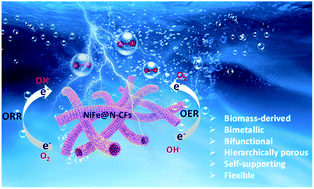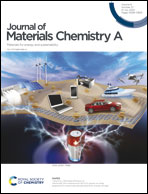A bimetallic alloy anchored on biomass-derived porous N-doped carbon fibers as a self-supporting bifunctional oxygen electrocatalyst for flexible Zn–air batteries†
Abstract
Rational design and construction of highly efficient and durable bifunctional non-noble metal electrocatalysts for reversible oxygen reduction (ORR) and evolution reactions (OER) are urgently required yet challenging for rechargeable Zn–air batteries. We develop here a facile and scalable “delignification–impregnation–carbonization” strategy to fabricate uniformly dispersed NiFe alloy nanoparticles anchored on bamboo stick-derived N-doped carbon fibers (NiFe@N-CFs) as an air cathode for flexible Zn–air batteries. Benefiting from the inherent cellulose fibers with abundant macroporous structures in the raw bamboo stick, the lignified carbon fibers possess an interconnected porous structure. In addition to having high electrical conductivity endowed by one-dimensional carbon fibers, this porous structure is favorable for exposure of more active surface sites for electrochemical reactions and fast mass transport. Moreover, the strong metal–support interaction between NiFe nanoparticles and N-doped carbon and their synergistic effect may also contribute to the catalytic performance. Consequently, the resultant electrocatalyst displays excellent catalytic activity and stability toward oxygen electrocatalysis with a remarkably small potential gap (ΔE) of 0.71 V between the half-wave potential (E1/2) of the ORR and the potential at 10 mA cm−2 (Ej=10) of the OER. When employed as a bifunctional air cathode in a liquid Zn–air battery, the NiFe@N-CF based device can achieve a peak power density of 102 mW cm−2 and specific capacity of 729 mA h gZn−1 and can be steadily cycled for 150 h at 10 mA cm−2, which is extraordinary. The NiFe@N-CFs can also be used as a self-supporting air cathode in a flexible quasi-solid-state Zn–air battery, showing high round-trip efficiency and mechanical stability. This work provides a new avenue for the development of energy-related devices by converting biomass into advanced electrodes.



 Please wait while we load your content...
Please wait while we load your content...